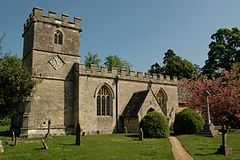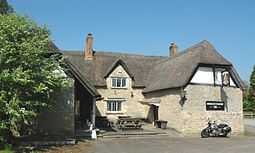South Leigh
- There is also a Southleigh in Devon.
| South Leigh | |
 St. James the Great parish church |
|
 South Leigh | |
| Population | 350 (2001 census)[1] |
|---|---|
| OS grid reference | SP3908 |
| Civil parish | South Leigh |
| District | West Oxfordshire |
| Shire county | Oxfordshire |
| Region | South East |
| Country | England |
| Sovereign state | United Kingdom |
| Post town | Witney |
| Postcode district | OX29 |
| Dialling code | 01993 |
| Police | Thames Valley |
| Fire | Oxfordshire |
| Ambulance | South Central |
| EU Parliament | South East England |
| UK Parliament | Witney |
| Website | South Leigh |
| |
South Leigh is a village and civil parish on Limb Brook, a small tributary of the River Thames, about 2.5 miles (4 km) east of Witney in Oxfordshire.
Manor
South Leigh was not mentioned in the Domesday Book of 1086, but was recorded in 1190 as Stanton Lega.[2]
The manor house was built in the second half of the 16th century. It is now called Church Farm House.[3]
In the middle of the 17th century William Gore acquired the manor. The Gores consolidated South Leigh as a separate estate within Stanton Harcourt parish, but this led to a series of disputes over landholdings intermixed between the two.[4] When Stanton Harcourt's common lands were being enclosed in 1773, its enclosure commissioners suggested promoting a single Parliamentary bill to enclose both estates.[4] Edward Gore and his tenants in South Leigh disagreed due to the unresolved boundary disputes and consequent disagreement over what lands would be allotted to whom under the enclosure award.[4] Instead Stanton Harcourt's enclosure commissioners were empowered to settle a definitive boundary between the two estates.[4]
Church and chapel
Church of England

The Church of England parish church of Saint James the Great began as a chapel of the parish of Stanton Harcourt, and remained so until 1868.[5] The oldest parts of the church building date from the latter part of the 12th century. The present chancel arch was built about 1300, the tower arch was built during the 14th century and the south doorway of the nave dates from about 1400. The church building was extensively altered in the 15th century: the north aisle and chapel were added, the bell tower was completed, and new windows were inserted in the south and east walls of the chancel.[5]
In 1871-72 the architect Ewan Christian restored the chancel and C.C. Rolfe began restoring the nave. Rolfe's cousin H.W. Moore completed the nave restoration in 1887-88.[6] During the restoration extensive 15th century wall paintings were discovered.[5] They include a Doom painting over the chancel arch,[7][8] the seven deadly sins,[9] Saint Michael weighing souls,[10] the Virgin Mary (originally part of an Annunciation scene)[5] and a rare painting of Saint Clement.[11] Burlison and Grylls heavily restored the paintings, re-drawing the weighing of souls at twice its original size.[5]
St. James' tower has a ring of eight bells, all of which were cast by Mears & Stainbank of the Whitechapel Bell Foundry in 1907.[12] The church has also a Sanctus bell cast by an unknown founder in about 1399.[12]
Methodist
John Wesley preached in South Leigh in 1771. A small Methodist congregation was established in the village by 1817, and met in private houses until it had its own chapel built in 1876. By 1968 the chapel was used for worship only once a month, and in 1969 it was sold.[13] It is now a private house.[14]
Economic and social history
Somewhen after 1773 the Gores sold South Leigh estate to John Sibthorp. In 1792, a generation after Stanton Harcourt's enclosure, two thirds of South Leigh's land remained unenclosed.[4] Sibthorp obtained an Act of Parliament that led to their enclosure in 1793.[4] About 1,663 acres (673 ha) were enclosed, of which the commissioners awarded 1,233 acres (499 ha) to Sibthorp.[4] South Leigh had coppices of pollarded elms to supply wood for various purposes. Between 1793 and 1795 Sibthorp had more than 3,000 trees around the estate, most of them pollarded elms, were felled to make fences for the new enclosures.[4] Sibthorp wrote that in the first ten months after the enclosure award:
I have worked up between 2000 and 3000 trees to posts and rails for my enclosure, besides a great quantity of timber used in the general repair of the farmhouses and cottage. I have quicked near upon 100 furlongs and fenced with posts and rails one-half of it. Gates and gateposts on the enclosures. I had three teams of horses constantly employed during the summer, yet unequal to my work.[15]

The Sibthorps felled large timber trees as well as wood, and early in the 19th century there were two major auctions of ash, elm and oak.[4]
The Witney Railway was built through the parish and opened in 1861. South Leigh railway station served the parish until 1962, when British Railways withdrew passenger services from the line. BR closed the line to freight traffic in 1970 and the track was dismantled sometime thereafter.
St. James' National School was built in 1871 and was reorganised as a junior school in 1931. Declining numbers of pupils led to the school being closed down in 1946.[16] The former school building is now the village hall.
St. James' College next to the parish church was founded in 1875 as a preparatory school. By 1923 it had become an orphanage, Holyrood Hospital.
Amenities

South Leigh has a public house: the Mason Arms gastropub,[17] whose traditional French menu and Old World wine list have been favourably reviewed by Raymond Blanc[18] and Marco Pierre White.[19] The Mason Arms has a number of celebrity customers and its facilities include a helipad for customers.[20]
The Mason Arms' landlord, Gerry Stonhill, is a cigar smoker who allowed his customers to continue smoking indoors in defiance of the ban on smoking in public buildings in England introduced in 2007 under the Health Act 2006. In April 2008 West Oxfordshire District Council successfully prosecuted Mr Stonhill at Witney Magistrates' Court, which imposed five separate fines and prosecution costs totalling £5,750.[21] After his conviction Mr Stonhill told news reporters: "You make up what you want, old boy. I'm not making any comment, except Tony Blair can stick his anti-smoking law up his arse".[21] However, he also conceded that thereafter he would comply with the law.[22]
References
- ↑ "Area selected: West Oxfordshire (Non-Metropolitan District)". Neighbourhood Statistics: Full Dataset View. Office for National Statistics. Retrieved 30 March 2010.
- ↑ Crossley & Elrington 1990, pp. 238–242.
- ↑ Crossley & Elrington 1990, pp. 242–244.
- ↑ 4.0 4.1 4.2 4.3 4.4 4.5 4.6 4.7 4.8 Crossley & Elrington, 1990, pages 244–249
- ↑ 5.0 5.1 5.2 5.3 5.4 Crossley & Elrington, 1990, pages 249–252
- ↑ Sherwood & Pevsner 1974, p. 769.
- ↑ Painted Church website: parts of Doom painting
- ↑ Painted Church website: Heaven and Hell at South Leigh
- ↑ Painted Church website: the Seven Deadly Sins
- ↑ Painted Church website: St. Michael Weighing Souls
- ↑ Painted Church website: St. Clement
- ↑ 12.0 12.1 "S Leigh S James Gt". Dove's Guide for Church Bell Ringers. Retrieved 29 March 2011.
- ↑ Crossley & Elrington 1990, pp. 252–253.
- ↑ Oxfordshire Churches website: South Leigh
- ↑ Emery 1974, p. 143.
- ↑ Crossley & Elrington 1990, p. 253.
- ↑ Gerry Stonhill's "Individual" Mason Arms
- ↑ Blanc, Raymond (29 September 2007). "Raymond Blanc on Le Gavroche – The Mason's Arms – Summertown Wine Cafe – Le Sud – Le Vin et l'Assiette". The Guardian (London). Retrieved 29 April 2011.
- ↑ Dixon, Rachel (27 March 2008). "Nibbles". The Guardian (London). Retrieved 29 April 2011.
- ↑ Gerry Stonhill's "Individual" Mason Arms: Arriving by helicopter
- ↑ 21.0 21.1 Horne, David (13 April 2008). "Smoking costs publican a £5,700 fine". Oxford Mail. Retrieved 29 April 2011.
- ↑ Horne, David (22 April 2008). "Fined landlord to 'toe the line'". Witney Gazette. Retrieved 29 April 2011.
Sources and further reading
- Bruce, M.R. (1972). "An Oxfordshire enclosure 1791–94". Top. Oxon. 18.
- Crossley, Alan; Elrington, C.R. (eds.); Baggs, A.P.; Blair, W.J.; Chance, Eleanor; Colvin, Christina; Cooper, Janet; Day, C.J.; Selwyn, Nesta; Townley, Simon C. (1990). A History of the County of Oxford, Volume 12: Wootton Hundred (South) including Woodstock. Victoria County History. pp. 238–253.
- Emery, Frank (1974). The Oxfordshire Landscape. The Making of the English Landscape. London: Hodder & Stoughton. pp. 88, 143, 187. ISBN 0-340-04301-6.
- Long, E.T. (1972). "Medieval Wall Paintings in Oxfordshire Churches". Oxoniensia (Oxfordshire Architectural and Historical Society). XXXVII.
- Sherwood, Jennifer; Pevsner, Nikolaus (1974). Oxfordshire. The Buildings of England. Harmondsworth: Penguin Books. pp. 769–771. ISBN 0-14-071045-0.
External links
![]() Media related to South Leigh at Wikimedia Commons
Media related to South Leigh at Wikimedia Commons
